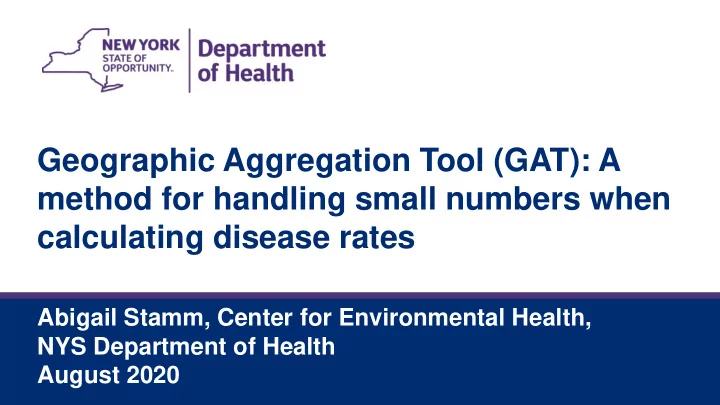

Geographic Aggregation Tool (GAT): A method for handling small numbers when calculating disease rates Abigail Stamm, Center for Environmental Health, NYS Department of Health August 2020
2 • Need for subcounty data • GAT • Outline What it does • How it works • Application examples
3 Why display subcounty data? Need: High risk areas Issues: • Smoothing/masking (county) • Small numbers (tract, town) Solution: Aggregation
4 GAT’s objective Aggregate small areas to: 1. Meet minimum counts 2. Standardize process
5 GAT’s process 1. Request user inputs 2. Run aggregation 3. Output shapefiles and documentation
6 User inputs • Shapefile • Minimum and maximum values • Boundaries • Exclusions • Aggregation method
7 Aggregation methods 1. Closest geographic centroid 2. Closest population- weighted centroid 3. Neighbor with the lowest count 4. Most similar neighbor
8 Closest geographic centroid
9 Closest geographic centroid
10 Closest population-weighted centroid
11 Neighbor with the lowest count
12 Most similar neighbor
13 Differences between GAT 2015 and GAT 2020 GAT 2015 GAT 2020 Format SAS and R scripts R package Log Minimal Comprehensive Maps Simple, not saved Detailed, saved to PDF Change settings dialog No Yes Population weighting SAS yes, R no Yes Exclusion criteria No Yes Maximum values No Yes
14 Applying GAT: disease • aggregation by population • closest population- weighted centroid
15 Applying GAT: mortality • aggregation by number of deaths • closest geographic centroid Fig. 6 Thematic Maps of the New York State Capital District after aggregation. a by life expectancy (image from Talbot et al. Population Health Metrics (2018) 16:1)
16 Takeaways How GAT can help you • Small areas with stable rates • Standardization and documentation • Customization
17 Acknowledgements CDC for funding Gwen LaSelva for code and testing NYS DOH EPHT team for testing and feedback Email me at abigail.stamm@health.ny.gov
18 Projects that have cited GAT Sherman RL, Henry KA, Tannenbaum SL, Feaster DJ, Kobetz E, Lee DJ. Prev Chronic Dis 2014;11:130264. DOI: http://dx.doi.org/10.5888/pcd11.130264 (referenced R v1.2) Werner AK, Strosnider HM. Spatial and Spatio-temporal Epidemiology 2020;33. DOI: https://doi.org/10.1016/j.sste.2020.100339 ((used SAS v1.31) Werner AK, Strosnider H, Kassinger C, Shin M. J Public Health Manag Pract . 2018;24(5):E20‐E27. doi:10.1097/PHH.0000000000000686 ((used SAS v1.31) Boscoe FP, Talbot TO, Kulldorff M. Geospat Health . 2016;11(1):304. Published 2016 Apr 18. doi:10.4081/gh.2016.304 (used SAS v1.31) Boothe VL, Fierro LA, Laurent A, Shih M. Global Diaspora News. Published 3/28/2020. https://www.globaldiasporanews.com/a-tool-to-improve-community-health-and-advance- health-equity/ (used R v1.33)
19 Example assessment map
20 Example log excerpt
Recommend
More recommend